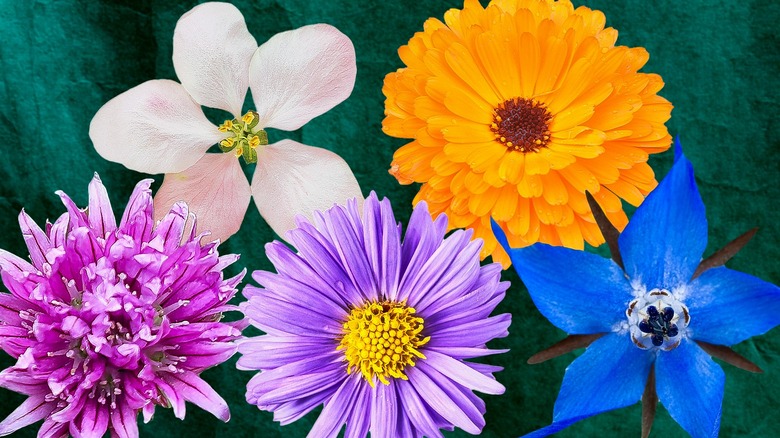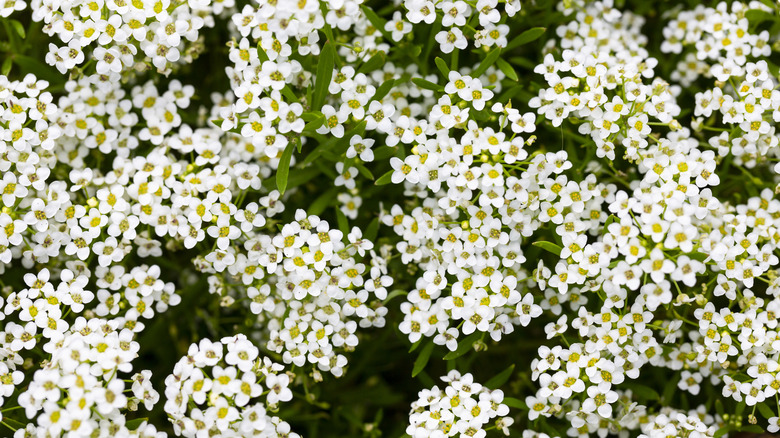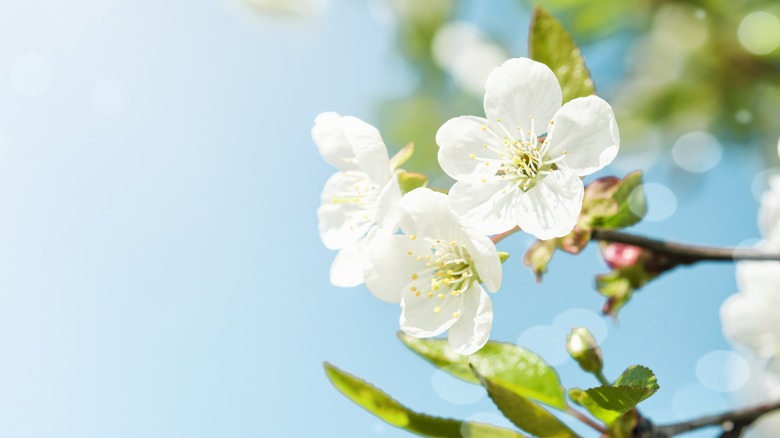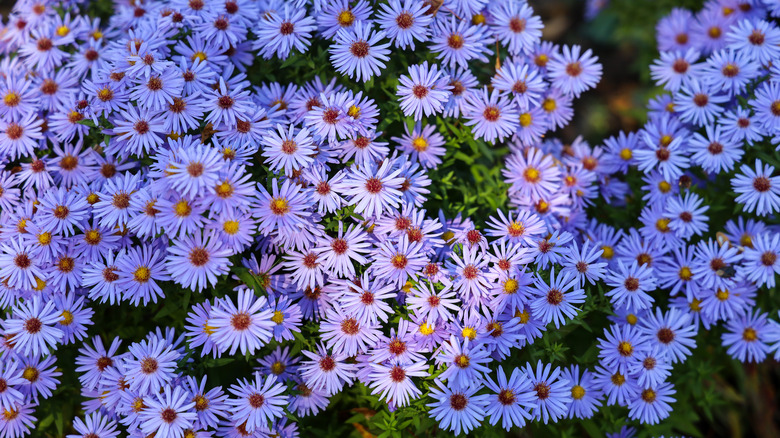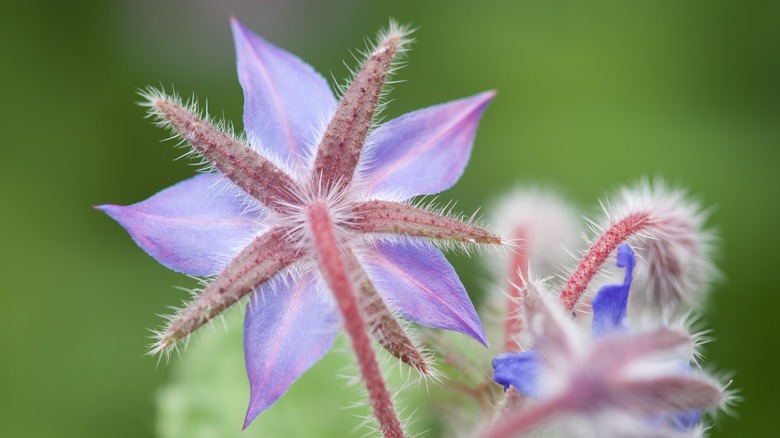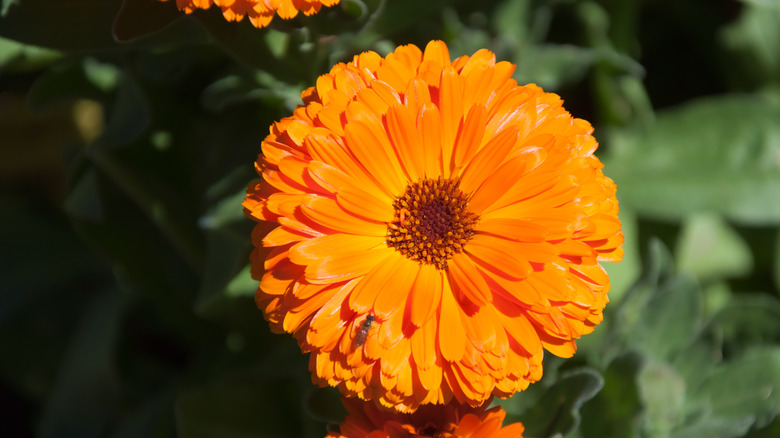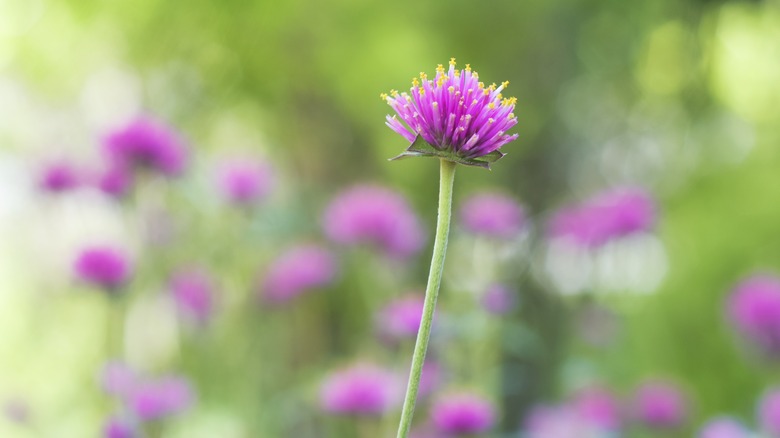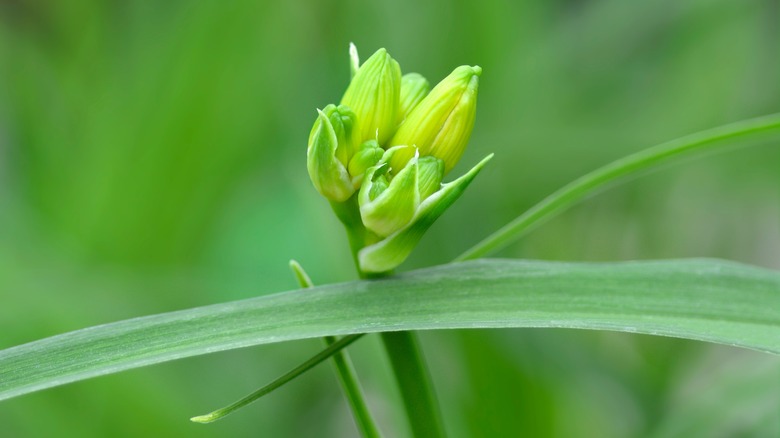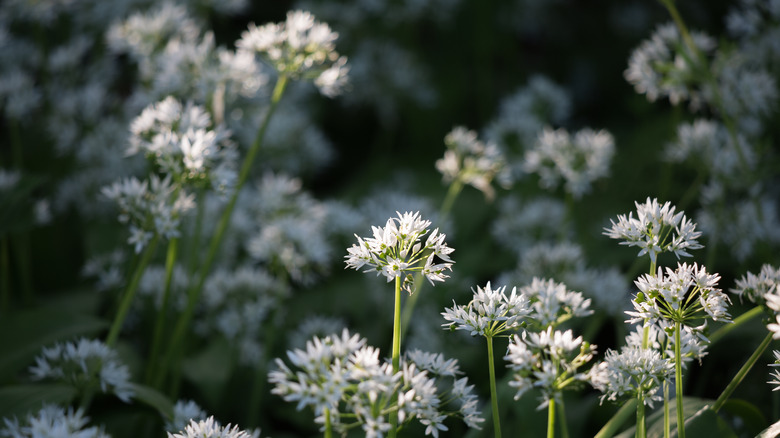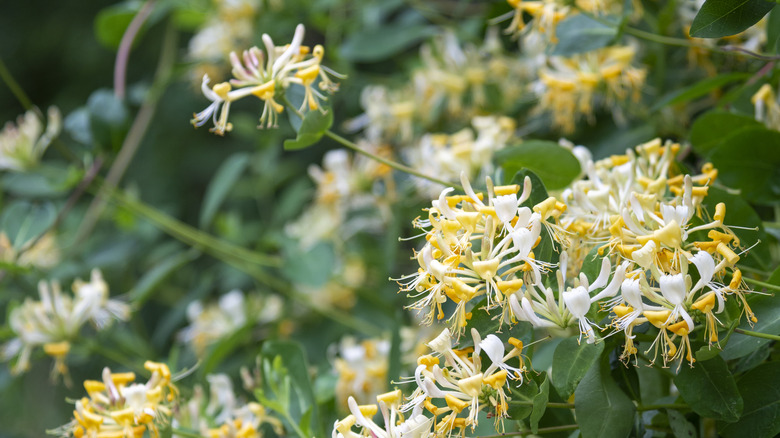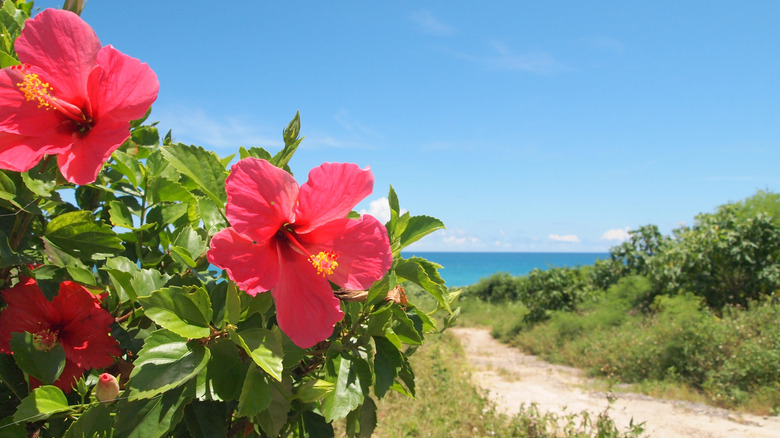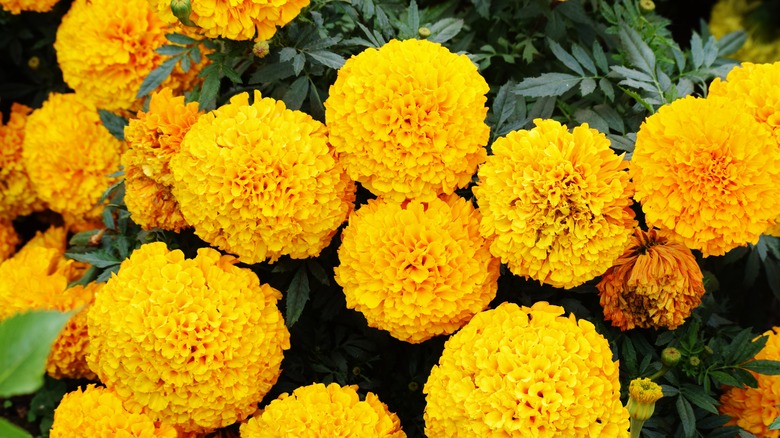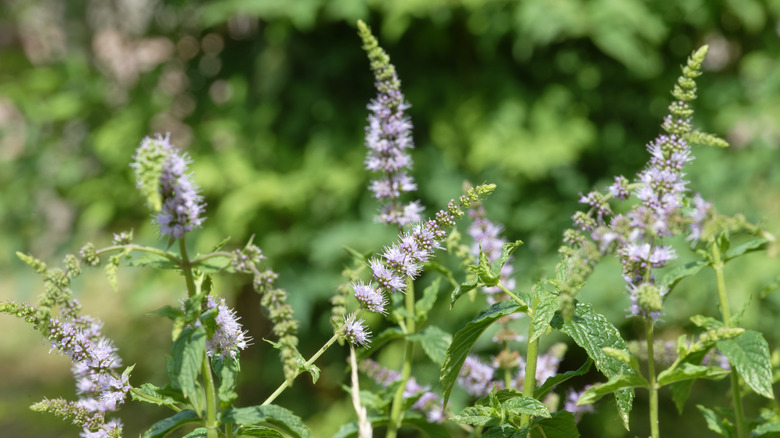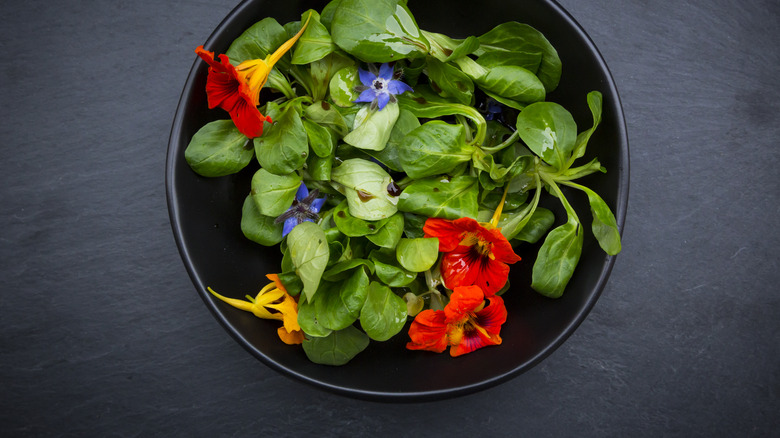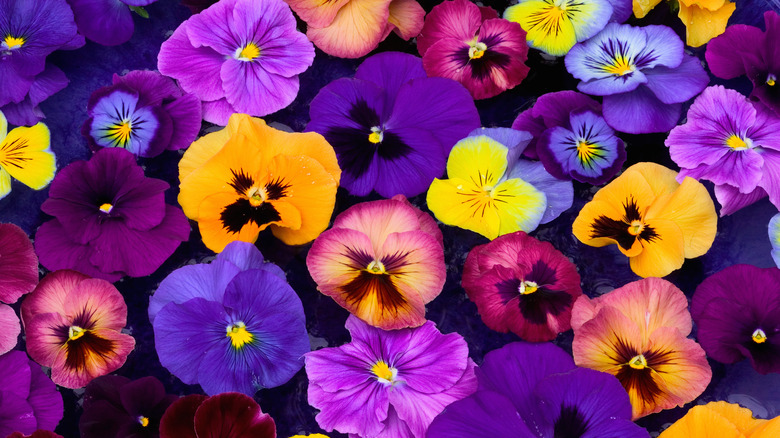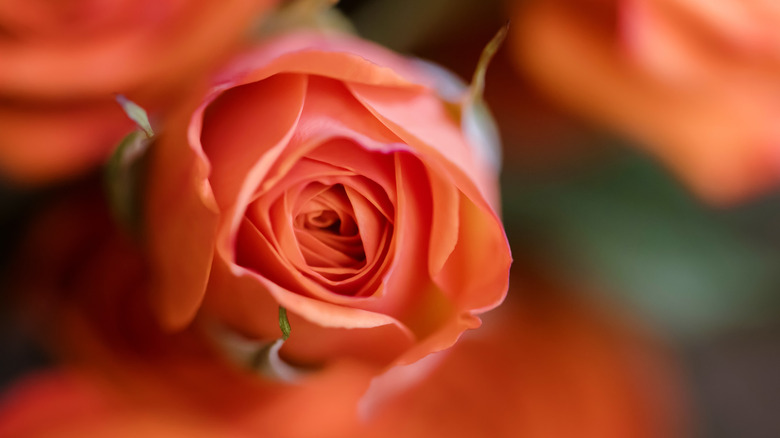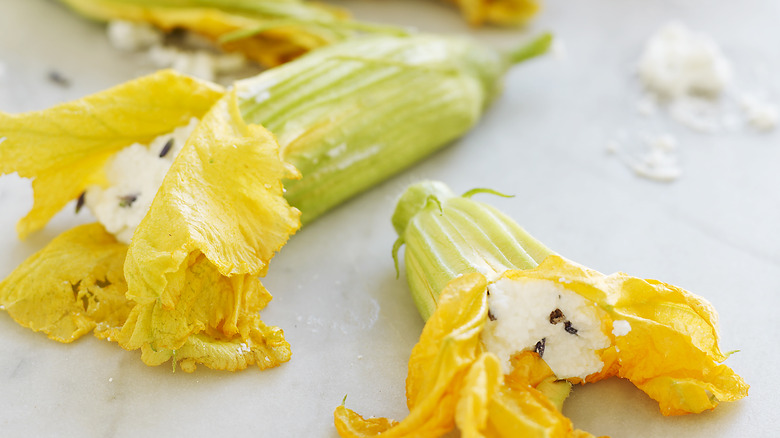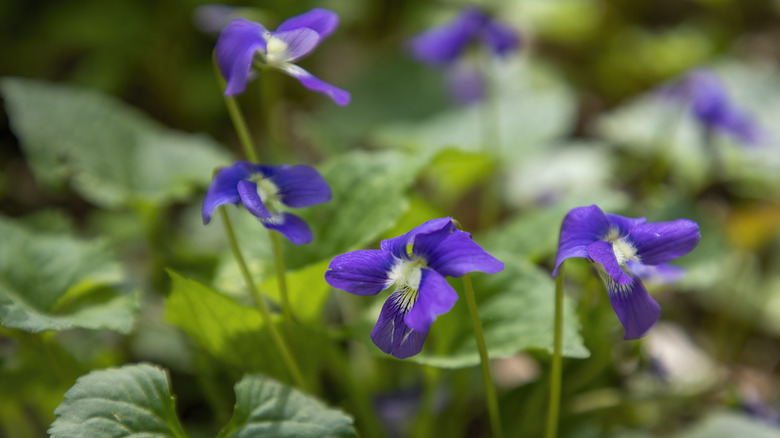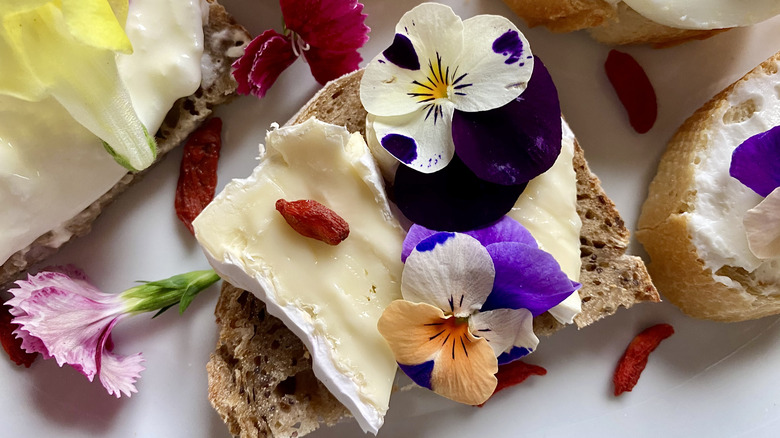17 Edible Flowers You Absolutely Must Know About
The savvy home chef knows that, as Giada de Laurentiis likes to say, we eat with our eyes first. While garnishing might seem frivolous, to anyone who wants to make and present beautiful food, it's an essential skill. If you want to make your food a little more demure, as the current trend has it, pretty garnishes are the way to go.
Unfortunately, while edible flowers can make your meals a little more mindful and demure, they are often overlooked by home chefs. This is a shame since so many of them are easy to grow in the yard or in pots, and many can be found at the grocery store or farmers market. The good news is that it's easy to mix some floral flair into your cooking, as long as you know where to look.
Indeed, there are so many edible flowers that it's impossible to cover them in a single post. If you're a diehard fan of the edible bloom, you might also want to check out sunflowers, zinnias, dianthus ... and so many more. For now, though, here's a handy guide on some flowers to use, how to get your grabby hands on them, and the best ways to put them to work in your kitchen.
Alyssum
Few things look cuter topping a salad or a cake than alyssum (Lobularia maritima), also known as sweet alyssum. It has a baby's breath-like appearance but with flower heads clustered on green pom-poms rather than bracts. The traditional color is white, but alyssum also ranges through the pink family to mauve and purple hues as well. An enthusiastic re-seeder, alyssum will pop up in your garden year after year if only you plant it once.
Both the flowers and the leaves of alyssum are edible and strongly flavored with a honey-like scent that works perfectly with salads, desserts, and cocktails. One of the cutest ideas is to pick the tiny blossoms off the flower head and sprinkle them into water or juice in ice cube trays. Once frozen, they will decorate a drink with aplomb.
Apple blossoms
Come spring and summer, gorgeous white and pink blooms appear in abundance on apple trees (Malus pumila and other Malus species) across the world. Their sweet flavor makes them well-suited to tea, jam, salads, and even whiskey. Even crab apples are edible, even if they aren't that tasty much of the time, and so are their flowers ... though they should be eaten in moderation.
Make sure you only harvest fresh, healthy flowers without spots or wilted parts, which could be a result of bacteria or insect activity. This goes for all flowers. You should also eat flowers the same day you pick them, ideally harvesting in the morning after the dew has dried and before the sun bears down, when they can lose their freshness.
Aster blossoms
Asters are members of the similarly named Asteraceae family, a family that also includes chrysanthemums, lettuce, safflower, stevia, and several other edible plants. Asters have beautiful blooms that come in a huge range of colors, from purple and yellow to periwinkle and multicolored patterns. You can eat their blooms whole, pull off the petals to garnish salads, or dry them for tea.
Asters grow multitudinously on branching stems, returning year after year to the garden without any effort on the part of the lucky gardener. (Fair warning: The lucky gardener will actually need to make an effort to control their enthusiastic growth, as this writer has discovered.) BTW, chamomile flowers are also in the aster family, and their white daisy-like blooms are also edible.
Borage
The bright blue, star-shaped, fuzzy-bottomed flowers of the borage plant (Borago officinalis) are too spectacular to resist adding to your fruit plate or summer cocktail. Cooler colors also make them a beautiful addition to green salads. Their cucumber flavor only adds to their suitability in all things fresh and summery. You can even crystallize them to make beautiful candy or cake decorations.
Borage is widely naturalized as a weed, most often spotted in woodlands and pastures. If you want to forage for borage (poetry!), you can check out your local parks and trails. Just make sure it's not illegal to collect there. That said, borage is so easy to grow that unless you truly love the act of collecting, it's easier to grow it in a container inside or outdoors.
Calendula flowers
Calendula (Calendula officinalis) is an undemanding plant that is easy to grow from seed, looks beautiful in the garden from early summer through fall, and blooms prolifically, especially if you remove spent blossoms. However, there's a caveat with this one: only eat the petals. The center and calyx (the green bump at the back of the blossom) are technically edible but often described as medicinal-tasting. Same with the leaves, which you can eat but that taste bitter.
There's a lot you can do with the petals, though. They come in all the warm colors, ranging from buff to yellow, apricot to orange, and red to burgundy, with variegated varieties as well. The delicate, slightly tart petals look beautiful on sliced figs, sprinkled into salads, or adorning desserts.
Chive flowers
As they are relatives of onions, shallots, and garlic, many people think of chives (Allium schoenoprasum) as a slightly spicy, onion-y addition to bagels or soups. However, the chive plant has more to offer than that, especially when it comes to the fluffy, light purple flowers that appear in spring and summer.
Slightly garlicky chive flowers are perfect for jazzing up fruit trays, veggie salads, and drinks. You can even float them on soups for major flair. Although the open purple flowers look like adorable little bee butts and are hard to resist, the unopened buds are delicious as well. They have a caper-like appearance, but are larger and light mauve. And much like capers, they are delicious when pickled and then added to cocktails or bagels.
Daylily buds
All parts of the daylily (plants in the Hemerocallis genus) are edible, from bulbs to stems to buds to flowers. But it is their buds that look particularly adorable nestled amidst a bed of wild greens or included in a stir-fry, although their showstopping flowers also make a daring garnish. When using daylily flowers, wait until they bloom fully, then harvest them after the dew has dried. You can use blossoms whole or pull off the petals to sprinkle in a salad.
Note that you shouldn't assume similar plants are also edible. For instance, while small yellow daylilies and daffodils have blooms that look much the same, all parts of daffodils are poisonous. For that reason, you should always look up the individual plant and part of the plant before you eat any of it. If you're not sure, do not eat.
Garlic flowers
Garlic (Allium sativum) is actually a member of the amaryllis family, home to the same dramatic bulbs that grace homes during the holidays. Unlike amaryllis, which is poisonous, all parts of the garlic plant are edible, from the classic grocery store bulb to the green shoots to the flower buds and purple blooms.
Together, the stem and unopened buds of garlic are known as scapes, a long curly stem that rises from the middle of the garlic's leaves in late spring. They are delicious in stir-fries and salads. You can grow them in your yard, of course, but garlic plants also grow wild all over the world. Hunt for them in fields and woodlands, primarily in disturbed areas.
Honeysuckle
If you didn't spend your childhood picking honeysuckle (Lonicera periclymenum) flowers, breaking off the back, and pulling out their long styles to suck the honeydew from the tip ... well, what were you even doing? It's important to know that while the leaves and flowers are edible, however, the berries are not. Make sure not to eat them and to educate children about them.
There is a species that has edible fruit, the sweetberry honeysuckle (Lonicera caerulea), but you must be sure that's what you're getting before you eat it. If you are lucky enough to get your hands on some, though, it's said to taste like a combination of raspberry, blueberry, and raisins.
As far as how to use honeysuckle in all things culinary, there are several applications. The honeysuckle bloom has a floral taste and is a nice addition to all things sweet. You can use it to make teas, jellies, syrups, and cordials. You can also float the pretty white and yellow blossoms on top of sodas and cocktails.
Hibiscus
Plants in the Genus Hibiscus, more commonly known as mallows, range in appearance but are generally known for their showy blossoms with one large, fused stamen growing out of the center. While commonly associated with the tropics and famous for its use in delicious teas (looking at you, Red Zinger), hibiscus flowers go great with food as well.
While all varieties of hibiscus flower are technically edible, some are definitely yummier than others. The one most commonly recommended for eating is the Hibiscus sabdariffa, also called roselle, red sorrel, and Florida cranberry, among other things. Its flowers are less showy than you might associate with hibiscus, but they are edible. So is its calyx, growing bright red at the base of the flower. Both can be used in jams, jellies, juices, syrups, and wine. As they are evergreen perennials, hibiscus plants also make a nice statement in the garden.
Marigolds
Marigolds, a group of flowers in the Tagetes genus, are basically magic. They are charming in the garden, bloom voraciously until fall, and are a natural pest repellant (though this may be because bugs enjoy eating them more than nearby plants). While they are perhaps best known in North America for their association with Dia de los Muertos (Day of the Dead) festivals due to the use of Mexican marigold (Targetes erecta) in celebrations, they are also a delicious edible flower.
Even more to their credit, they are available in a huge range of hues, from the same bright yellow as mustard flowers (also edible) to orange, red, variegated, and color mixes. They range from spicy to citrusy in flavor, and while you can eat them whole, the petals are tastiest. As long as they have a moderate amount of water and bright sunlight, they could not be easier to grow.
Mint flowers
Mint (plants in the genus Mentha) is delicious in both leaf and flower form. In fact, most Mediterranean herbs have tasty flowers, with a flavor similar to but milder than their leaves. Mint's pretty purple blooms go well on salads, veggie platters, fruit plates, and desserts. You can also get mint as part of an herb seed mix, which will give you thyme, sage, lavender, and other herbs that have edible flowers as well. Culinary herbs tend to become bitter once they flower, so moving your attention to the blooms is a good idea in any case.
Other edible flowers on the herbal side of the spectrum include mustard, broccoli, and the ever-delicious fennel. Red clover has a similar licorice-like flavor. Bee blossom and johnny-jump-ups are minty in flavor but more mellow.
Nasturtiums
Nasturtium flowers (Tropaeolum majus) are absolutely gorgeous, ranging in color from golden yellows to deep scarlets. They look amazing on salad, and their peppery bite goes with everything from spicy arugula to mild veggies. If you love that hot, herbal, spiced flavor that you get from arugula, you might want to consider adding nasturtium leaves to your salad as well, since they're also edible.
Plus, they're so easy to grow from seed in most temperate yards, making them an easy addition to your edible flower garden. Fun fact: The hotter the temperatures in which nasturtium are grown, the spicier they'll be. Just make sure to keep your eye on nasturtiums when growing them in the garden, as pests such as aphids and caterpillars really like them.
Pansies
A sweet-faced flower that comes in a huge variety of colors, pansies (in the genus Viola) are adorable and edible, and you absolutely must include them in your culinary blossom lineup. Although the classic pansy (Viola tricolor) is colored in white, purple, and yellow with variegated patterns at the throat, this is far from the only option. Pansies also come in red, orange, pink, white, deep blue, lavender, periwinkle, pale yellow, burgundy, and combinations of these colors.
Unlike many other flowers on this list, which want full sun and summer months, pansies are there for you in the spring and fall. They are equally noteworthy because they grow in cooler weather and enjoy some shade, perfect for gardeners who don't have the eight hours of sunlight required for many blooms. The taste of pansies is described as mild, grassy, and tangy, so they're suitable for everything from salads and cakes to jams and cocktails.
Roses
As Shakespeare possibly once said, a rose by any other name would taste as delicious. And even if he didn't say that (he didn't), he'd still be right: All members of the Rosa genus, of which there are more than 350 originally bred from as few as 10 species, are edible. Over the years, the sweet perfume of roses has been captured over the ages as cologne, incense, and potpourri. No surprise that we love the aroma of it in our food as well.
Roses are members of the same family in which you'll find apples, cherries, and berries, so it makes sense that roses are edible from blossom to leaf. Rose hips are especially popular in the fall, either dried as tea or candied.
But most pertinently for the purposes of this article, the petals of any rose cultivar are beautiful in food or as a garnish. You can freeze them into edible flower ice cubes, toss them in salads, sprinkle them over dessert or fruit plates, and use them in cocktails. Just make sure to remove the white parts of the petal, which can be bitter.
Squash blossoms
Famous for their ability to contain a good amount of cheese and then hold up to battering and deep-fat frying, squash blossoms are a truly delicious addition to the appetizer spread. You can use blooms from both summer and winter squash, all of which are members of the Cucurbita genus. The exciting news is that other plants in the squash family, such as cucumber and watermelon, also have edible blossoms as well. If you're looking to use cucurbit blossoms in salads or on fruit plates, go for the smaller flowers, such as those of cucumbers. Squash flowers are usually too voluminous to work well as a garnish.
Looking for a novel way to eat cheese? Try saffron and mascarpone stuffed squash blossoms. Not only are fried squash blossoms tasty as heck, but they're also very meta, since saffron is itself the product of an edible flower. (Saffron strands are actually the stigmas of a Crocus sativus.)
Violets
Violets, like pansies, are members of the Viola family. There are several species you can eat, but do not assume you can eat all of them. Wood violets (Viola papilionacea) are edible, as are their young leaves. They taste sweet and flowery, making them best suited to cocktails and desserts, although a fun tea sandwich with cream cheese can work as well.
Other species of violet are edible too, in colors ranging from violet and purple to blue and white, as well as multicolored species. Just stay away from the yellow ones, which can be hard to digest. You should also avoid African violets, which as the name might suggest are not part of the same family and are nonedible.
Violets are adorable, make for an excellent groundcover, and arrive in spring, when not many other flowers are available. As long as you know what you're looking for, you can even eat the wild variety. For example, common blue violets (Viola sororia) often grow as a weed but are perfectly edible. Closely related violas, with soft petals and a lovely, sweet flavor, are also tasty, beautiful, and decorative.
Edible flower safety tips
Although there are plenty of edible flowers, you shouldn't make any assumptions. For instance, while the fruit of domesticated cherry trees is delicious and safe to eat, raw wild cherries contain prussic acid, which can be dangerous in large quantities, even though it's safe in smaller ones. Similarly, the blossoms of cherry trees contain compounds that turn into cyanide when chewed. Probably best to confine your cherry blossoms to cake decorations instead.
Always do your research before assuming a flower is edible simply because it's associated with an edible fruit. Also never assume that simply because something is in the same genus as an edible species, it is safe. Cherry and cherry laurel are both species of Prunus, for instance, but the latter are not edible.
